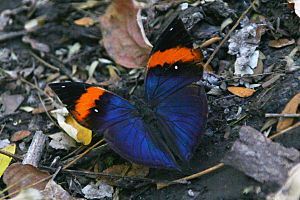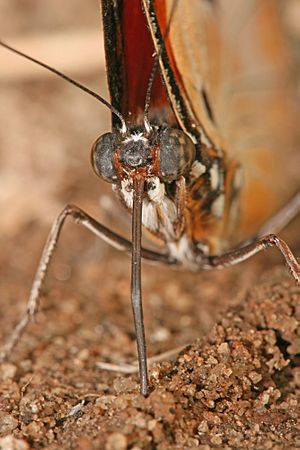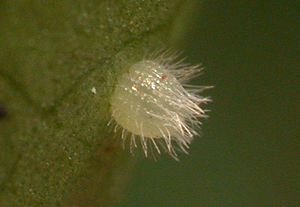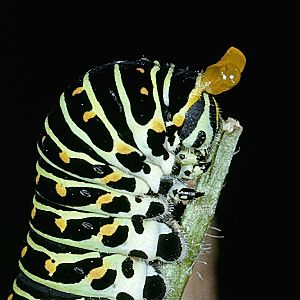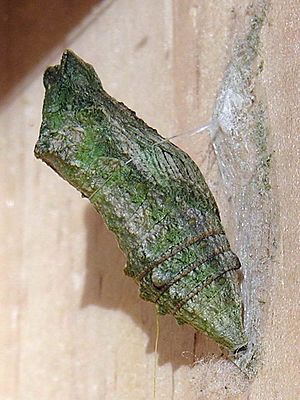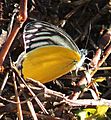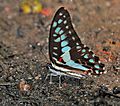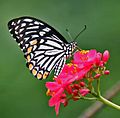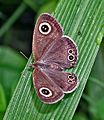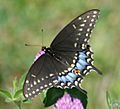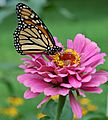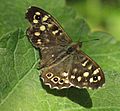Butterfly facts for kids
Quick facts for kids Butterflies |
|
|---|---|
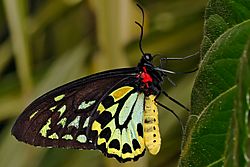 |
|
| Male Cairns birdwing, the largest butterfly in Australia (Melbourne Zoo). | |
| Scientific classification | |
| Kingdom: | |
| Phylum: | |
| Class: | |
| Order: | |
| Suborder: |
Rhopalocera
|
| Superfamilies and families | |
|
|
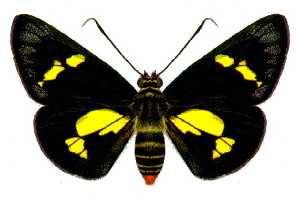
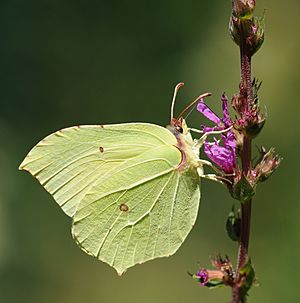
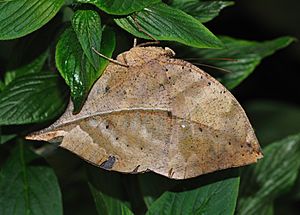
A butterfly is a type of insect that usually flies during the day. They belong to a group called Rhopalocera. Butterflies are very similar to moths, and they actually developed from moths a long time ago.
Butterflies and flowering plants need each other. Butterfly larvae (which are caterpillars) eat plants. Adult butterflies drink nectar from flowers and lay their eggs on plants. Over time, butterflies and flowering plants have changed together, helping each other survive. Butterflies are also known for their amazing colors, patterns, and beautiful wings.
Butterflies are one of the last big groups of insects to appear on Earth. The oldest butterfly fossils we've found are about 40 to 50 million years old.
Like moths, butterflies have four wings. These wings are covered with tiny scales. When a butterfly is not flying, it usually folds its wings over its back. Butterfly wings have many different patterns and are often very bright. There are many kinds of butterflies, and often the males and females look a little different. Watching butterflies is a fun hobby.
Like all insects that go through a full metamorphosis, a butterfly's life has four clear stages. It starts as an egg. The egg hatches into a larva, which is a caterpillar. After growing, the caterpillar changes into a chrysalis (which is like a cocoon). Inside the chrysalis, it transforms into a butterfly. Finally, the butterfly comes out and lays more eggs, starting the cycle again.
Contents
How do Butterflies Protect Themselves?
Who Eats Butterflies?
The main animals that eat butterflies are birds. Monkeys and reptiles that live in trees also hunt butterflies. Some insects and spiders eat them too. Since monkeys and reptiles can see colors well, the bright colors of butterflies help them in different ways.
Butterfly Defenses
The amazing colors and patterns on butterfly wings and bodies have special jobs. Here are some ways butterflies use their colors to stay safe:
- Camouflage: This helps the butterfly hide from animals that want to eat it.
- Signaling to other animals:
- Warning colors: These bright colors tell other animals, "Don't eat me! I taste bad or am poisonous!"
- Mimicry: Some butterflies copy the warning colors of other species that are dangerous to eat.
- Sexual selection: Colors and patterns help butterflies find a mate.
- Diversion:
- Startle defense: A sudden flash of bright color or "eyespots" can surprise a predator and give the butterfly time to escape.
The way butterflies use their colors changes from one type of butterfly to another. Even caterpillars have colors that help them. The poisonous stuff that makes some butterflies taste bad comes from the plants their caterpillars eat.
What is a Butterfly's Body Like?
Like most insects, butterflies have three main body parts. These are the head, the thorax, and the abdomen. A hard outer shell called an exoskeleton protects their body. The body is made of sections called segments. Flexible parts between the segments let the butterfly move. All three body parts are covered in tiny scales. These scales give the butterfly its color.
Wings and Flight
Butterflies have a special way of flying. They usually don't fly in straight lines. Their flight is often described as "fluttering." Some butterflies can fly long distances, like the monarch butterfly during its migration. Others never leave the small area where they were born. Butterflies can still fly well even if their wings get a little damaged. You can often see damaged wings on older butterflies, but they keep flying just fine.
The Head
The head is the first part of the butterfly's body. It holds the eyes, mouth parts, and antennae.
A butterfly's eyes are large. Each eye is made of many smaller eyes, called compound eyes. Butterflies don't see as many colors as humans, but they can see ultraviolet light.
Adult butterflies don't have jaws. Instead, they have a special mouth part for sucking liquids, called a proboscis. The proboscis is made of two hollow tubes joined together. When the butterfly isn't using it, the proboscis is coiled up like a spring in its head. It can uncoil it to drink nectar.
A butterfly's antennae help it smell and keep its balance. Most butterflies have antennae that are thicker at the end, like a club. Some butterflies, like Skippers, have a hook at the end instead of a club.
The Thorax
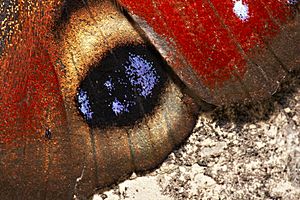
The thorax is the middle part of the body. It has three sections. The legs and wings are attached to the thorax.
A butterfly has three pairs of legs. They use their legs for walking, holding onto things, and even tasting. Each leg has four main parts. At the end of each foot, there are two tiny claws. Butterflies in the family Nymphalidae have very short front legs. They keep these legs close to their bodies, making it look like they only have two pairs of legs.
Butterflies have two pairs of wings. Each wing has hollow veins inside. The colors and patterns on butterfly wings come from tiny, overlapping scales. These scales are attached to the wing. If you touch a butterfly, these tiny scales can rub off.
The Abdomen
The abdomen is the third and last part of the body. It has ten sections and is much softer than the head and thorax. At the end of the abdomen are the reproductive organs. Male butterflies have special parts called claspers to hold onto the female during mating. Female butterflies have a tube for laying eggs.
What is a Butterfly's Life Cycle?
Butterflies go through a process called complete metamorphosis. This means their life has four distinct stages. The first stage is the egg. The second is the caterpillar (also called the larva). The third stage is the chrysalis (also called the pupa). The fourth and final stage is the adult butterfly (sometimes called the imago).
The Egg Stage
A female butterfly lays her eggs on or near the plant that the caterpillar will eat. This plant is called the "food plant." The female chooses where to lay her eggs using her sense of smell, taste, touch, and sight. Most butterflies lay just one egg on a food plant. Others lay groups of five to over 100 eggs. Most species lay their eggs on the leaves, but some lay them on flowers, stems, bark, or fruit.
Butterfly eggs come in many shapes and colors. They can be round, oval, or flattened. Some eggshells have ribs. The most common egg colors are yellow and green. The eggs will turn darker just before they hatch. Some butterflies hatch in a day, while others can take months.
The Caterpillar Stage
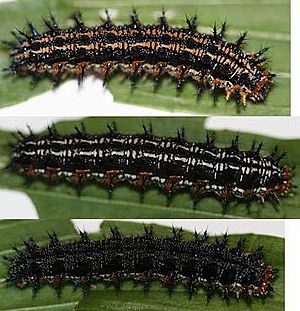
Butterfly caterpillars come in many sizes, colors, and shapes. They might have spines, bristles, or soft body parts. All caterpillars have 13 body sections. The first three sections make up the thorax and have three pairs of "true legs." The other 10 sections make up the abdomen. The abdomen has five pairs of soft legs called prolegs. These prolegs have tiny hooks called crochets that help them hold onto things.
A caterpillar's skin does not grow. As the caterpillar gets bigger inside its skin, the skin becomes too tight. To grow, the caterpillar sheds its old skin. A new, larger skin is underneath. This process is called molting. A caterpillar will molt four to five times before it turns into a pupa. Each period between molts is called an instar.
All caterpillars can make silk. Silk starts as a liquid in their salivary glands. The caterpillar pulls out the silk into a small thread, which hardens as soon as it touches the air. Caterpillars use silk to make nests or cocoons.
Most caterpillars eat leaves from plants or trees. Many types of caterpillars will only eat a few specific kinds of plants. If a caterpillar cannot find its food plant, it will starve to death.
Some caterpillars are "tended" by ants. These caterpillars have special glands that make a sweet liquid called honeydew, which ants love. In return for the honeydew, the ants protect the caterpillars from animals that want to eat them. Some caterpillars can also make sounds to "call" the ants when they are in danger.
Caterpillars in the family Papilionidae have a special organ called an osmeterium. This organ is a gland that smells bad and is shaped like a snake's tongue. It is usually hidden behind the caterpillar's head. When a predator tries to eat the caterpillar, it will release the osmeterium to scare the predator away.
The Pupa Stage
The pupa forms after the caterpillar's last molt. The caterpillar finds a special place to pupate (turn into a pupa). Its digestive tract empties. Then, the caterpillar sheds its skin, and the pupa is revealed. Inside the pupa, the caterpillar's body changes completely to become a butterfly.
The pupa cannot move. It is attached to an object by tiny hooks at the end of its abdomen. These hooks form a part called the cremaster. The pupa has many tiny holes that allow air to move in and out.
Many pupae are easy for predators to find. Some caterpillars make shelters from silk and leaves to protect themselves when they become pupae. These shelters are called cocoons. Most butterfly pupae do not have cocoons. Instead, they are brown or green to camouflage themselves among leaves and branches. Pupae without cocoons are called chrysalids or chrysalises.
Why are Butterflies in Danger?
Some butterflies are in trouble because their habitat is disappearing. When forests and grasslands are destroyed, some types of butterflies lose their places to feed and lay eggs. To help, some people plant "butterfly gardens" with flowers that have lots of nectar for butterflies to eat. Some people also grow plants that butterflies lay eggs on, so they can watch the caterpillars hatch and grow. Chemical sprays used to kill garden pests can also harm or kill butterflies.
Some Colorful Butterflies
Monarch Butterfly Gallery
-
A monarch butterfly, with closed wings, feeding on nectar from a garden flower.
See also
- Differences between butterflies and moths
- How animals defend themselves
- Animal colour
- Moth
- Lepidoptera
Images for kids
-
Monarch migration route.
-
Mating pair of spotted fritillaries on greater pignut.
-
Eggs of black-veined white (Aporia crataegi) on apple leaf.
-
Aposematic caterpillar of Papilio machaon, in threat pose.
-
Mutualism: ant tending a lycaenid caterpillar, Catapaecilma major.
-
Cryptic countershaded caterpillar of a hawkmoth, Ceratomia amyntor.
-
An Australian painted lady feeding on a flowering shrub.
-
Braconid parasitoidal wasp (Apanteles species) cocoons attached to lime butterfly (Papilio demoleus) caterpillar.
-
Heliconius warns off predators with Müllerian mimicry.
-
Eyespots of speckled wood (Pararge aegeria) distract predators from attacking the head. This insect can still fly with a damaged left hindwing.
-
Ancient Egyptian relief sculpture, 26th dynasty, Thebes. c. 664–525 BC.
-
Butterfly and Chinese wisteria, by Xü Xi. Early Song Dynasty, c. 970.
-
Alice meets the caterpillar. Illustration by Sir John Tenniel in Lewis Carroll's Alice in Wonderland, c. 1865.
-
Nō robe Japan 1700s. Silk embroidered with silk thread and stenciled with gold foil.
-
Prodryas persephone, a Late Eocene butterfly from the Florissant Fossil Beds, 1887 engraving.
-
Lithopsyche antiqua, an Early Oligocene butterfly from the Bembridge Marls, Isle of Wight, 1889 engraving.
See also
 In Spanish: Rhopalocera para niños
In Spanish: Rhopalocera para niños


